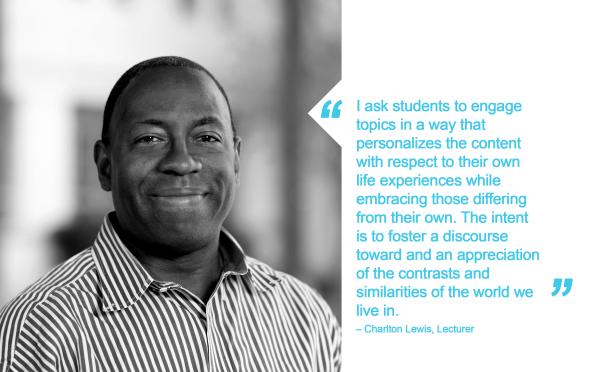Charlton Lewis, Faculty

In this post, we hear from Charlton Lewis. With a specialization in the areas of architectural design and construction, Charlton has taught continuously at the School of Architecture since 2006 and holds a B.Arch and M.Arch from The University of Texas at Austin.
What program(s) are you associated with in the School of Architecture? How long have you been at the university?
Teaching at the school since 2006, I have been primarily associated with the architecture program and teaching studio, seminar, and construction/technology courses. Additionally, I am Co-Chair of the Committee for Diversity + Equity (CODE), the Faculty Liaison for the National Organization of Minority Architecture Students (NOMAS), and an Administrator of the Professional Residency Program.
In what ways have you incorporated diversity and equity in your teaching and research?
The delineation of my own efforts, particularly in lecture, seminar, and studio courses, parallels the stated goals and vision of UTSOA as a whole regarding diversity and an enlightened educational process and constituency. In the seminar and lecture courses I teach, I often ask students to engage topics in a manner that personalizes the content to their own specific backgrounds and life experiences while embracing an understanding of those differing from their own. The specific purpose is to foster a rich discourse toward and an appreciation of the contrasts and similarities of the world we live in and design towards.
Similarly, in the studio setting, I encourage students to share and apply their own unique cultural, societal, and contextual understandings and then look beyond that to grasp other viewpoints and realities. And the context of the studio exploration and constituencies addressed therein emphasize the need to address a multitude and diversity of peoples and cultures.
Throughout the semester, I avidly look for opportunities to introduce discussions regarding the multiplicity of viewpoints that exist within the world. By introducing diversity and innovation in the classroom, students learn the benefits of an active discourse; gain the maturity required to engage in such a discourse; and begin to cast away their own preconceptions. It is through this approach to diversity in the classroom that my students, early in their academic career, become quite comfortable discussing the challenges inherent in the world today.
What does diversity mean to you?
It means the cultivation of a diversity of backgrounds, life experiences, cultures, and opinions within both the academic and professional environments we engage.
Can you describe the sense of community at the School?
My understanding of the “sense of community" within UTSOA is that there is an inherent openness, and receptivity to others amongst its constituency, whether students, faculty, or staff. But there is also a tacit understanding that the surface has only been scratched in regards to the ideal of a diverse and inclusive academic environment and the implications of that ideal to this community.
What are your aspirations –big or small– for the future?
To further pursue the discussion and goals of diversity and inclusivity within UTSOA and beyond. NOMAS has ambitions to increase its presence within and beyond the campus with outreach efforts targeting the greater Austin community, particularly its youth. I hope to also build upon previous efforts in recruiting, cultivating, and retaining a diverse undergraduate and graduate student body in addition to fostering a diversity of engagement at the professional level through the Professional Residency Program. Lastly, I hope to remain a participant in the ongoing efforts to promote a discourse of diversity and inclusivity within UTSOA.

